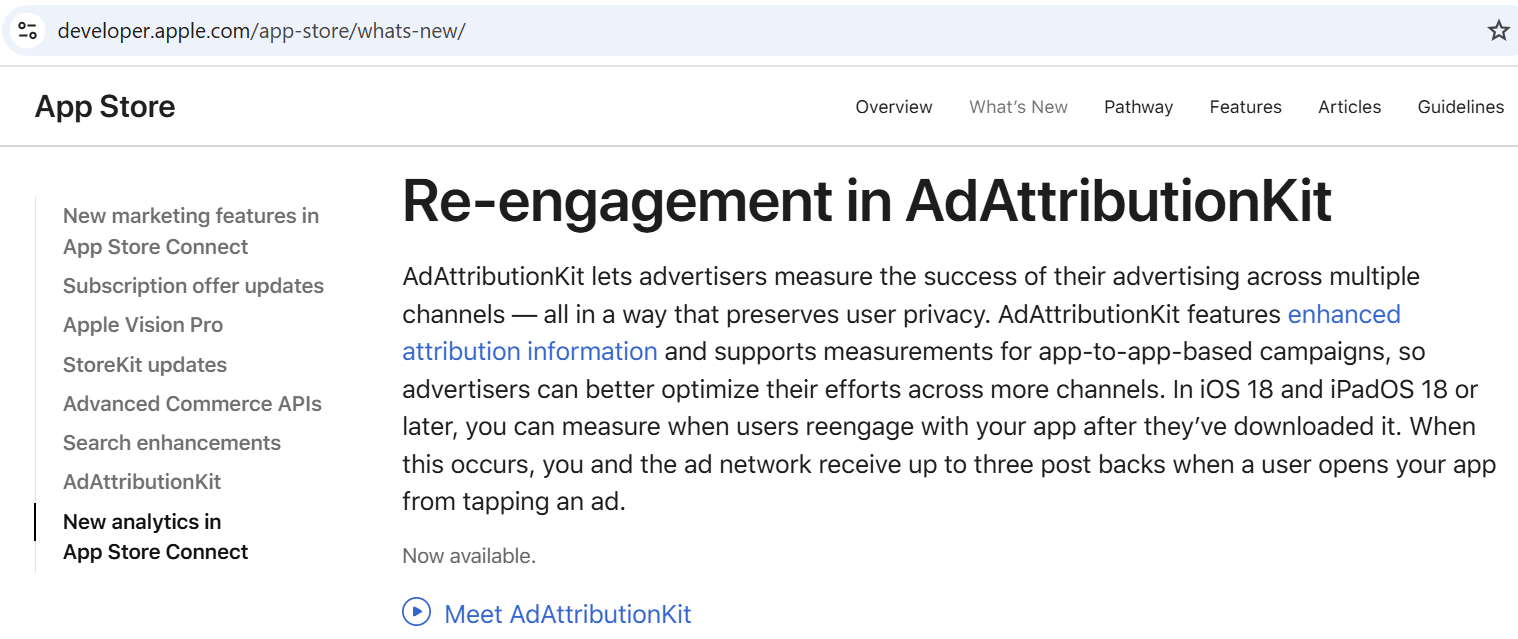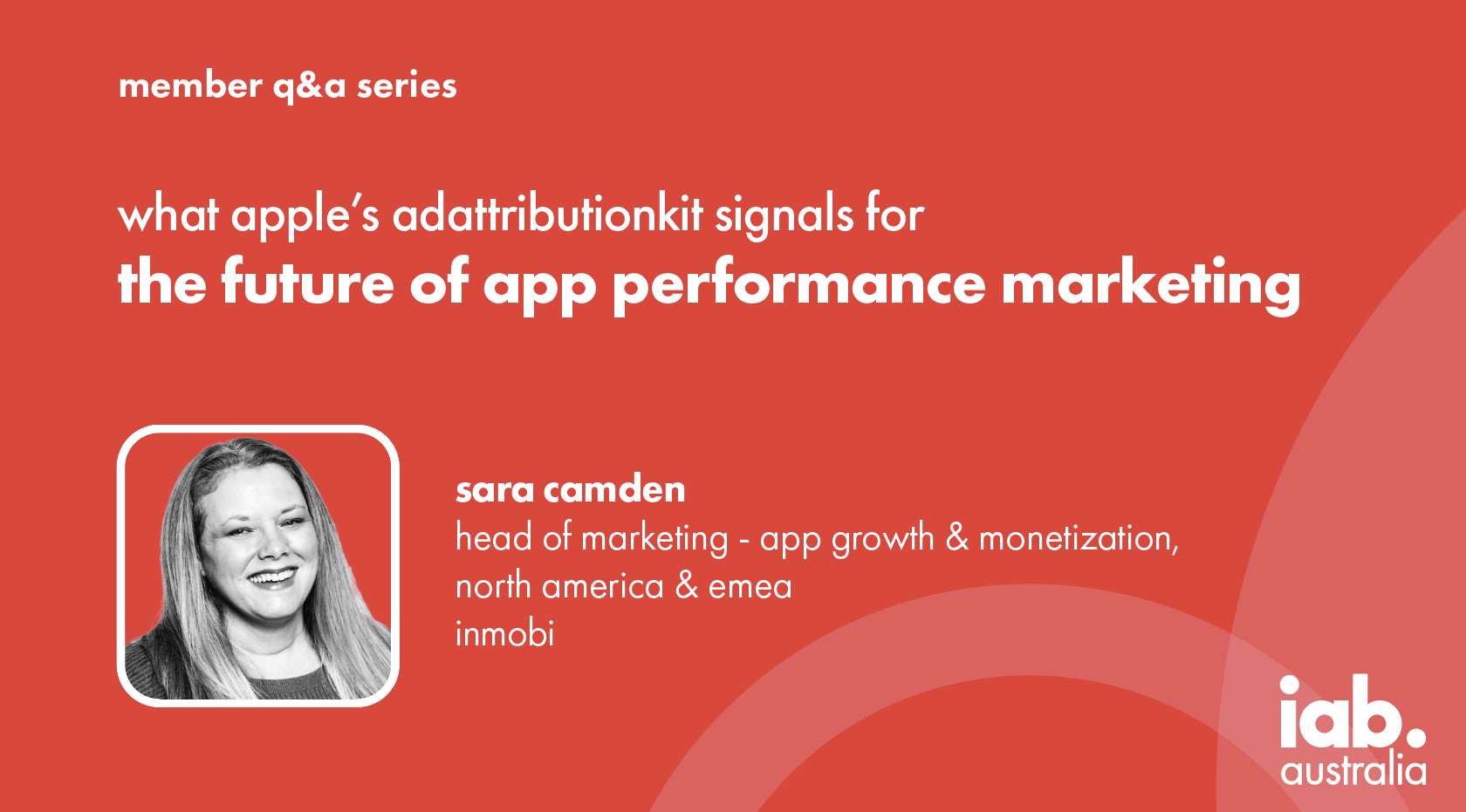IAB Australia has recently published an update (click here) on Apple’s new measurement framework designed to enhance ad attribution capabilities in iOS.
As a follow-up, we have engaged with Sara Camden – who is the Head of App Performance & Monetization Marketing at InMobi with some questions related to “What Apple’s AdAttributionKit Signals for the Future of App Performance Marketing”.
How important for industry is the release of the AdAttributionKit for measuring the effectiveness of ad campaigns in iOS?
While AdAttributionKit (AAK) is a far less dramatic update from a technical feature standpoint than its most recent predecessor SKAdNetwork (SKAN) 4.0, AAK does send a very strong signal that Apple is committed to making privacy-safe attribution work for the performance advertising ecosystem long-term. AAK was announced not only as a replacement for SKAN on iOS, but also its web-based companion Private Click Measurement (PCM) for Safari, indicating momentum towards unified cross-channel measurement.
This rebranding of Apple’s two siloed privacy-preserving attribution frameworks for in-app and web-based conversions comes complete with its own logo which now displays prominently alongside other core frameworks such as StoreKit and App Store Connect.

If the widely revered marketing minds at Apple think AdAttributionKit is worthy of dedicated investment from a branding standpoint, I advise digital marketers to approach it with the same level of priority in mind.
Please provide some insights into the additional capabilities that the AAK brings to measurement for marketers.
The vast majority of fundamental mechanics found in SKAN 4.0 remain constant in AAK with a handful of notable enhancements that address some of the most noticeable functionality gaps of its SKAN predecessors. Namely:
- Support for measuring app re-engagement: Unlike SKAN which only attributed conversions associated with an app install, AAK has the ability to attribute conversion actions taken by users who already have an advertiser’s app installed.
- More accurate multi-touch attribution: AAK builds upon SKAN’s ability to assign credit to a single winning ad and up to 5 assists by clearing up ambiguity around clicks and views so that attribution credit is awarded based on a much more realistic depiction of how a user interacted with an ad.
- Attributing conversions to alternative app marketplaces: In response to the European Digital Markets Act (DMA) requirements that Apple provide support for developers who want to use alternative app marketplaces to drive installs and purchases, AAK has built-in support for attributing these conversion events that happen outside the iOS App Store.
- New developer mode for testing AAK: iOS 18 includes a new setting that can be toggled on in iOS devices for the purposes of testing AAK implementations. This new testing mode allows developers to remove the randomized delays and fixed conversion window timings built into live AAK implementations, allowing end-to-end testing of attribution feedback loops to be done much faster and more easily.
The majority of Australian consumers own Apple mobile devices (both phones & tablets). Are you concerned that many buyers and sellers are not doing enough to enable the measurement of ad effectiveness within in-app environments generally?
It’s perfectly understandable that many advertisers and publishers have not fully transitioned to Apple’s privacy-preserving attribution frameworks given their complexity and the existence of IP-address based workarounds as viable solutions. My recommendation is to deploy a hybrid approach to campaign performance measurement that takes advantage of all available signals, including a healthy investment level in SKAN/AAK.
Apple has been very clear with app developers that attempts to identify iOS users who have not consented to sharing their Identifier for Advertisers (IDFA) via AppTrackingTransparency (ATT) violates their developer policies. At the same time, Apple has yet to strongly enforce these policies or implement technical features to thwart violations, hence why probabilistic IP-based workarounds continue to flourish unabetted.
In my opinion, it seems inevitable that Apple’s policies prohibiting workarounds that attempt to identify iOS users without consent via ATT will eventually grow some teeth, which will effectively make AAK the law of the land. Testing SKAN/AAK campaign attribution alongside IP-based workarounds as well as ATT opted-in conversions arms advertisers and their partners with important historical data that will make the full transition to privacy-preserving attribution far smoother when or if that need arises.
What other recommendations would you have for marketers with regards to activation and measurement within in-app environments?
In addition to healthy investment in testing SKAN/AAK alongside ID-based and probabilistic attribution methodologies, here are some other tips to share:
- Lean on agency, MMP and media partners with deep expertise in iOS and AAK. There’s no avoiding the cold, hard facts that SKAN and AAK have added an overwhelming amount of complexity to measuring app campaign performance on iOS. But, the great news is that MMPs, agencies and media partners such as InMobi have been making significant investments in making privacy-preserving attribution work for large-scale advertisers across every app category since its earliest beginnings. Lean on their learnings to make this transformation much less painful for your business.
- Leverage a hybrid measurement approach to continually fine-tune your media mix. In addition to taking advantage of all available privacy-preserving, ID-based and probabilistic attribution signals, you should also embrace additional methods such as incrementality testing and media mix modeling (MMM). A welcomed byproduct of SKAN and AAK is that it removes the opportunity for some large ad networks to operate as ‘walled gardens’ that grade their own homework, with Apple now serving as the arbiter of truth in assigning attribution credit. Use this to your advantage to gain a clearer picture of the incremental value each media partner adds to your growth strategies.
- Explore how artificial intelligence and machine learning can address signal loss. There are a wealth of use cases for AI/ML to address degraded and delayed attribution signals that leading adtech platforms are implementing very effectively.
- Prioritize first-party data strategies. Research shows time and again that consumers are willing to share their data with an app when there’s a clear value exchange. Deploy and optimize consent management through AppTrackingTransparency, and explore safely sharing first-party conversion insights with performance media partners through MMP integrations, which will exponentially improve the speed and effectiveness with which AI/ML powered adtech platforms can optimize your campaigns.
- Keep creative fresh and optimized. Take advantage of all available ad sizes and formats, as well as specialized iOS features such as SKOverlay and SKStoreProductViewController to continually fuel incremental gains in campaign performance.
What excites you most about what we could expect to see in 2025?
As someone who has tracked ATT and SKAN closely from the start, AAK signifies like never before that Apple is listening to the performance advertising ecosystem and adapting its privacy-preserving attribution approach based on real market feedback, which gives me great optimism.
Looking ahead, here are a couple things on my ‘wish list’:
- Audience targeting, re-targeting, suppression and frequency capping: SKAN and AAK have made great strides in solving for privacy-safe campaign performance measurement, and I’d now love to see them make notable progress towards how marketers can target and re-target, or suppress, audiences while respecting user privacy.
- Cross-channel unified measurement: AdAttributionKit marks a convergence of in-app and web-based conversion paths in name alone. My hope is that the multitude of customer journeys a user can take along the path to conversion will eventually be accounted for in one unified framework that includes not only the open in-app and web ecosystem, but also Apple’s own advertising platform as well as other ad channels such as CTV and DOOH.
If you’d like a deeper dive on AdAttributionKit and what’s ahead for the app marketing ecosystem, check out my handy guide on inmobi.com
